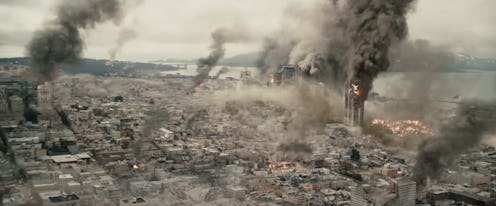News
Is "San Andreas" Scientifically Accurate?

The movie San Andreas hit theaters on Friday, and the $100 million film about a California earthquake surrounding the state’s fault line stars Dwayne “The Rock” Johnson as a rescue helicopter pilot on the search for his missing daughter. The film has already gotten a lot of press and attention because of the budget and the stunts, but also because of the proximity of the film’s scheduled release date with the very real earthquake in Nepal recently. But though the movie might have coincided with reality in its timing, does the film actually hold any basis in reality? Here’s a look into just how scientifically accurate San Andreas is.
Well, for starters, the notion that a massive earthquake such as that in the film could develop around the San Andreas Fault line is spot on, as the fault line running through the middle of California already does account for a lot of the state’s earthquakes. Moreover, according to the International Business Times, the fault line does run through many of California’s highly populated areas, which makes the widespread destruction and chaos depicted in the film at least somewhat plausible. All in all, the film’s general concept isn’t so flawed.
And, according to The Rock, the film is way more than the typical action movie or disaster film. He shared this with his Instagram followers:
Our goal was to make a movie that was highly entertaining, but weighted with quality from years of work and research.
But, as far as some other aspects of the movie, it seems like a little more research needed to be done. For instance, a quote in the San Andreas trailer insinuates that the earthquake would be felt on the East Coast, which is dubious, and the film’s trailer also depicts the Hoover Dam — the massive 726-foot man-made dam located on the border of Arizona and Nevada — being destroyed by the California earthquake. This raised the eyebrows of Gary Robbins, a San Diego Union-Tribune reporter, and he decided to do some investigating.
The verdict? The dam is probably way too far from the quake to be affected, especially as significantly as it is in the movie. San Diego State seismologist Tom Rockwell told The San Diego Union-Tribune:
…my gut feeling is that the dam is too far away to be destroyed by a quake on the San Andreas. Shaking gets weaker the further you get from an earthquake. And the dam is 195 miles [east] of the San Andreas. The ground acceleration would be very low by the point.
But just because the earthquake likely wouldn’t reach as far as the movie portrays it doesn’t mean it wouldn’t be devastatingly destructive. According to scientists, the largest earthquake on the San Andreas fault could be in the 8.0 to 8.1-magnitude range. To put that into perspective, Nepal’s earthquake a few weeks ago was
a 7.8-magnitude. More than 8,200 people were killed.
So, though the science in San Andreas isn’t exactly perfect, the show of just how scary and devastating an earthquake can be definitely will have some truth in it.
Image: Warner Bros